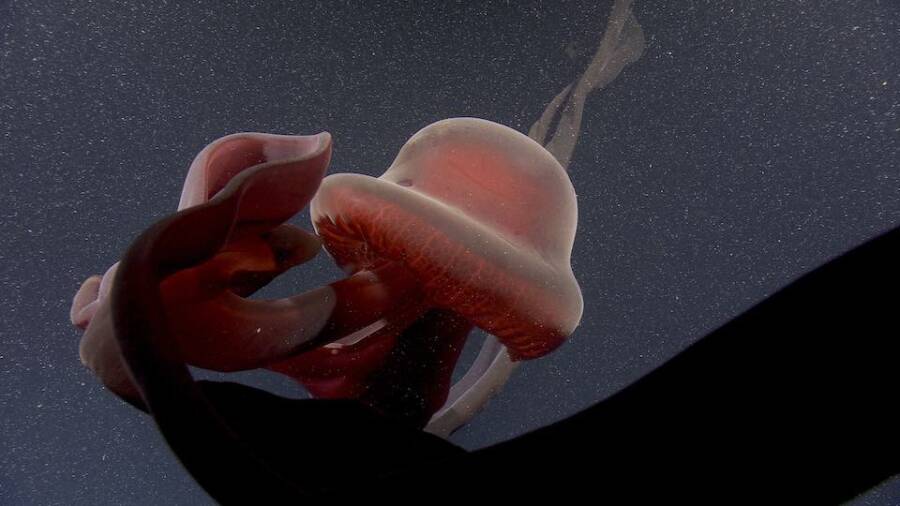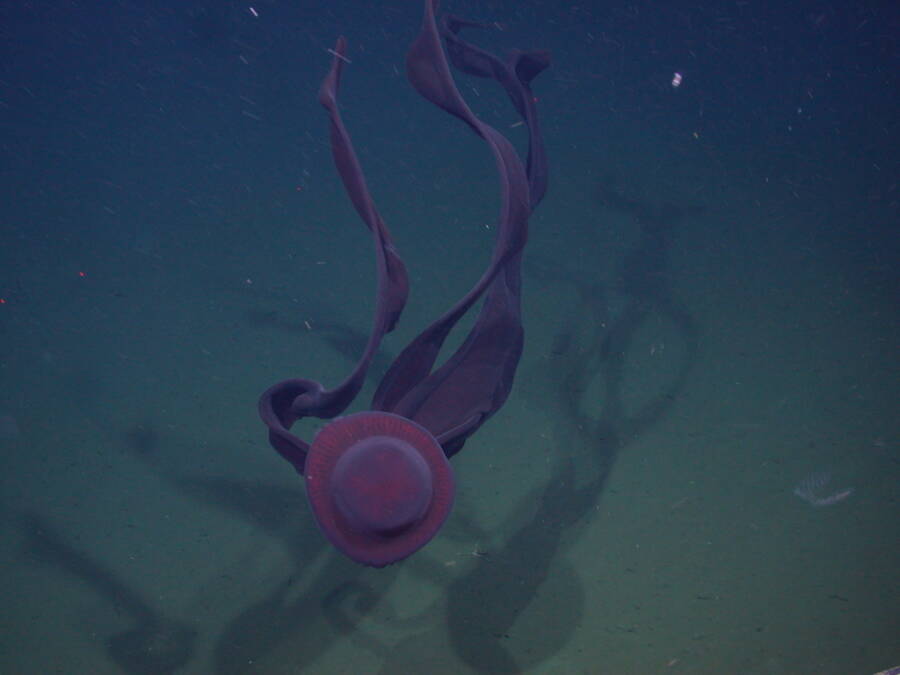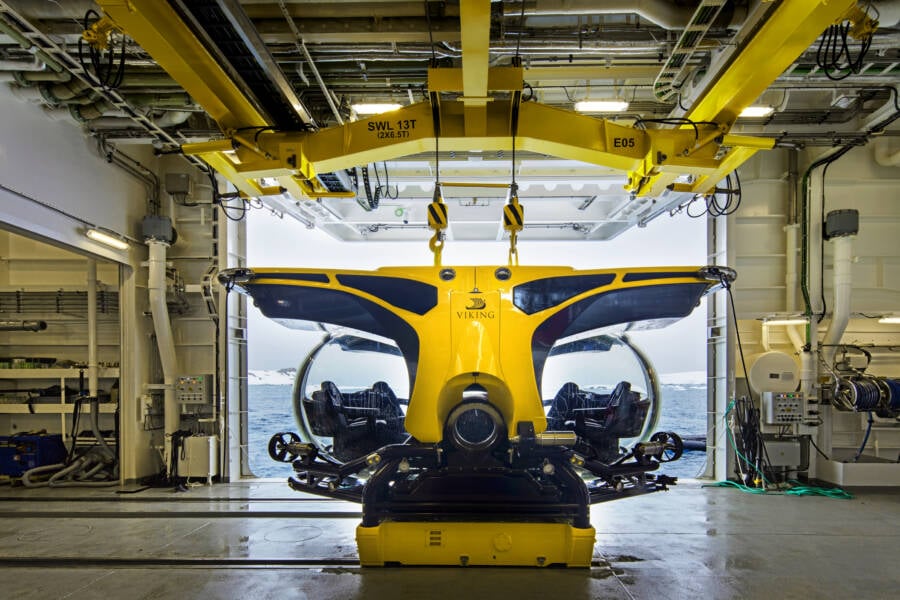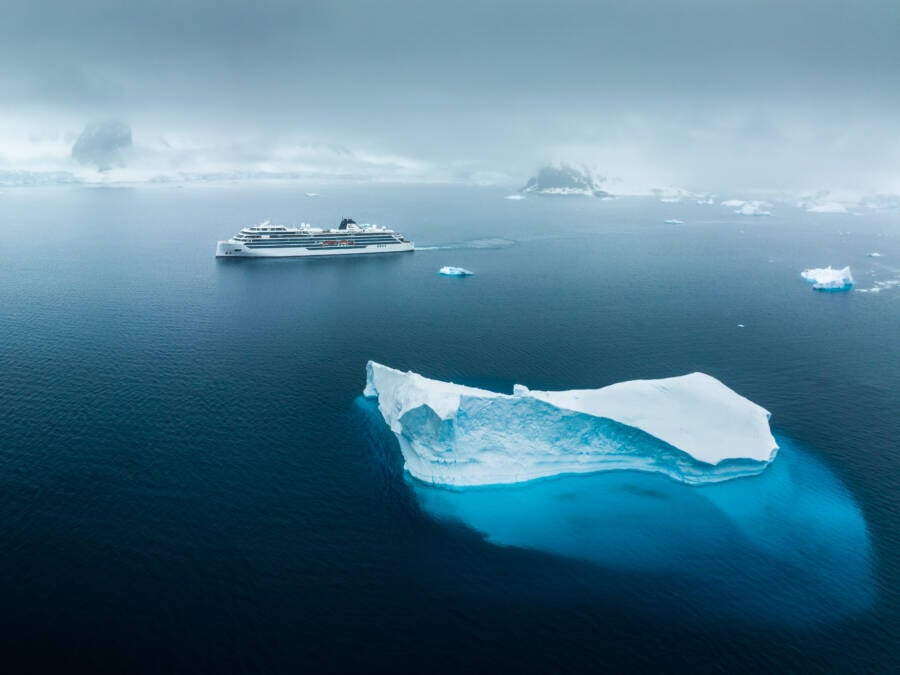Since they were first described in 1910, fewer than 130 sightings have ever been made of this mysterious deep-sea creature.

Monterey Bay Aquarium Research InstituteGiant phantom jellyfish sightings are especially rare as these creatures live 21,900 feet below the ocean’s surface, in what is known as the “midnight zone.”
In early 2022, guests on a submersible deployed by cruise line operator Viking were met with a strange and otherworldly sight: a massive jellyfish with UFO-shaped bells and streaming ribbons stretching as long as 30 feet.
Some of the guests captured photographs of the fascinating and bizarre jellyfish, and researchers realized the guests had come across an incredibly rare giant phantom jellyfish.
“I instantly recognised it for what it was and, given the rarity of sightings, was flooded with excitement,” Daniel Moore, one of Viking Expedition’s chief scientists, told Live Science.
This sighting, plus two others that followed shortly after, then became the subject of a new study published in the journal Polar Research.
“On every sighting the jellyfish appears to be swimming slowly, gently pulsing its bell for propulsion,” said Moore, who led the study. “They don’t appear to have shown any inclination towards the lights of the submersible or reaction to our presence.”
The giant phantom jellyfish were observed at depths of 260 feet, 285 feet, and 920 feet — typically, they occupy depths below 20,000 feet. Curiously, giant phantom jellyfish are present in every ocean on Earth except the Arctic, but they are encountered at higher depths in the Antarctic.
The reason for this is still unknown.
One potential explanation, according to Moore, is that the jellyfish may swim to higher depths in order to expose themselves to ultraviolet radiation and get rid of parasites.
It’s also possible that the upwelling deep water found in the Southern Ocean simply carries the jellyfish upward.

Monterey Bay Aquarium Research InstituteThe giant phantom jellyfish has been observed with a small fish living alongside it in a mutually beneficial relationship. The fish receives shelter and protection, and in return, keeps parasites from attaching to the jellyfish.
In any case, these recent sightings are changing what scientists know about the mysterious deep-sea creatures. Of course, our understanding of giant phantom jellyfish has historically been limited by a number of factors, primarily cost and technology.
Until recently, it was extremely difficult for researchers to reach the depths of the ocean. The deepest dive on record took place in 2019 and reached a depth of roughly 36,000 feet, and even though technology has improved to allow for these remarkable deep dives, it was still incredibly expensive.
Because of this, researchers have had a difficult time observing creatures that can only be found in the deepest parts of the ocean — though Moore and Viking Expeditions are hoping to change that.
“It is extraordinary that we know so little about such large marine creatures as the giant phantom jellyfish,” Moore told Forbes. “However now we have the means to make regular observations at greater depths than previously possible, which provides an exciting opportunity for discovery.”
Viking Expeditions bills itself as “the thinking person’s cruise,” aiming to enlighten its passengers about each destination’s history, heritage, and environments, both natural and built.

VikingA Viking Expedition ship’s submarine.
This dedication to science and research is especially prominent on the company’s two 378-passenger expedition ships, Viking Polaris and Viking Octantis, which have resident scientists, onboard laboratories, and expedition teams of at least 36 experts on every cruise.
Viking also has scientific partnerships with several prestigious labs, including the University of Cambridge’s Scott Polar Research Institute, the Norwegian Institute of Water Research, the Norwegian Polar Institute, and the Cornell Lab of Ornithology.
Researchers from these labs often perform field research on Viking cruises, and guests can interact with them to learn more about their research.
“At the core of Viking Expeditions is the goal to do meaningful scientific work,” Viking’s chairman, Torstein Hagen, told Forbes.
Part of this goal includes allowing guests to explore the underwater world at no extra cost via the expedition ships’ yellow submarines (appropriately named John, Paul, George, and Ringo). The submarines have enough space for six guests and a pilot, who can observe the world beneath the surface through 270-degree spherical windows.
And while these tours are designed to help guests learn and enjoy their time aboard the ships, they are also proving to be beneficial for the scientific community and researchers hoping to discover more about Earth’s oceans.
In fact, following the new study from Moore and other Viking scientists, Viking is now the first cruise liner to publish a scientific paper.

VikingViking Octantis in Antarctica.
That said, these explorations don’t come without risk.
On Feb. 2, 2023, the U.S. Coast Guard announced that it would be joining an international investigation into four deaths and other casualties involving American citizens on passenger tours of the Antarctic — including one death on the Viking Polaris.
The U.S. Coast Guard said the Antarctic environment poses a “unique high-risk” to explorers, and they hope to improve marine safety and prevent similar incidents from happening in the future.
Looking to learn more about the mysteries of jellyfish? Dive into these 35 mesmerizing jellyfish photos and facts. Or, read about the immortal jellyfish — and what it could mean for mankind.





